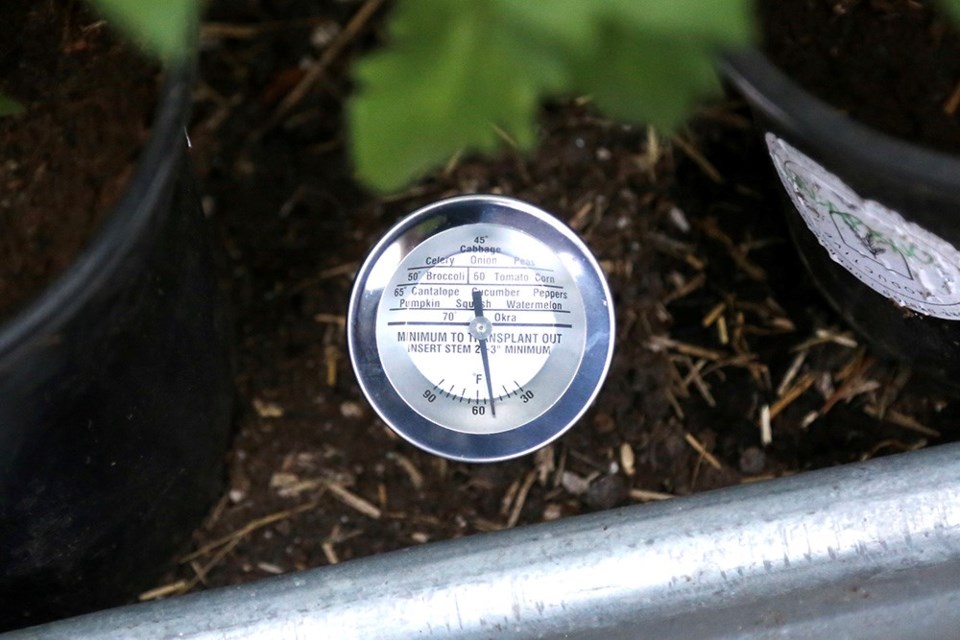Some years ago I heard a CBC radio show guest suggest that the best time to plant out tomato and pepper seedlings is when you can sit on bare soil in your birthday suit, comfortably, for a minute or two.
Yikes! It isn’t time yet, clearly. We had light frost earlier this week. For weeks now, as I’ve made my morning rounds, the thermometer on the side of the garden shed hovered stubbornly between 4.5 °C and 7 °C. This morning, a sodden 6.5 °C.
I feel for plant nursery operators whose livelihoods depend, more-or-less, on just a handful of predictable gardening months. It can’t be easy, juggling truckloads of tender seedlings around, dodging cold, wet and wind.
I have trouble here at home, managing the short trip that my tomato and pepper seedlings take outside to a barely heated old greenhouse, and then keeping the soil chocolate cake moist but not wet, warmish but not warm, sunlit but not scorched, fed but not forced, until I can plant out.
I seed-started indoors three weeks late this year, confident that like children who start kindergarten younger than most, my transplants will catch-up and bear fruit at the usual and expected time. With this cold however, I am still too early, and have now run out of greenhouse bench space.
The living soils that I trialed, with the intention of building climate change resilience, yielded too many plants. I have moved several one-gallon tomato plants to a spot under the south-facing eaves of the house, strategically and beneficially equidistant between the dryer vent and the stove fan exhaust. I haven’t planted them, rather set the pots on the surface of a large mobile planter in which the soil temperature remains a bum-chilling 10 °C.
The wildcard this year, and moving forward as climate change lives up to its name, is unpredictability. For non-native plants especially, be they (yes, plants are people too) food crops, annual flowers, perennials or trees, the creation and maintenance of hospitable environments will surely become more challenging.
Nightshades (Solanaceae), a family of flowering plants primarily native to Africa and the hot Americas, are particularly cold sensitive. My nightshade starts include tomatoes, peppers, husk tomatoes (ground cherries), eggplant, and garden huckleberries (Solanum melanocerasum).
There is microbiological logic to local gardening wisdom that advises a minimum soil temperature of 16 °C for planting out nightshades, and an optimal range of 21-35 °C. Plants consume soil microorganisms as they grow (notice how soil disappears over time in a root-bound pot), and they drink in micronutrients.
This elegant, simple-in-principal process depends on complex relationships between mechanics, chemistry and biology, all operating at optimal seasonal temperatures. Because soil microbes thrive between 16 and 29 °C and start tapping out at un-seasonal highs and lows, timing is everything.
In my gardens, living soils slumber somewhat during the winter, and wake up again in the spring. Technically, soil-borne microorganisms, or microbes, are invisible to the naked eye (fungi, bacteria, archaea, protozoa), but some tiny barely visible insects and nematodes are included in the mix.
These busy little guys cycle sunlight, elements and each other in a beautiful and crazy amazing waste-nothing interdependent system of living soil – the soil food web – that supports plants and in turn all terrestrial life. It’s bloody amazing!
Native plants do best in their native environments of course, but there are things we can do now here at home to support non-natives and all plants. We can add organic composts, mulches, worm castings (poop), organic micronutrients, fungi, activated biochar, organic compost teas and foliar sprays, and other natural boosters and inoculants to feed and increase soil biology.
In my inexpert but well-intentioned opinion, adding worm castings to soil is the quickest, most cost-effective hedge against climate change stressors. Consider sinking a DIY worm compost into your garden or raised bed (see my blog), or buy castings or castings-enriched living soil. When worms feed, they ingest bacteria, fungi, nematodes, protozoa, etc, and their super-charged poop is teeming with beneficial microorganisms. Add them, feed them, keep them alive!
Terra Flora Organics in Chilliwack grows stellar artisanal living soils and mulches, composts, inoculants, worms, castings and more, and, they can arrange delivery to the north shore and Vancouver. Soil thermometer, West Coast Seeds.
Laura Marie Neubert is a West Vancouver-based urban permaculture designer. Follow her on Instagram @upfrontandbeautiful, learn more about permaculture by visiting her Upfront & Beautiful website or email your questions to her here.
For a taste of permaculture, click on the YouTube link below:
(Video - Courtesy of West Vancouver Memorial Library)



